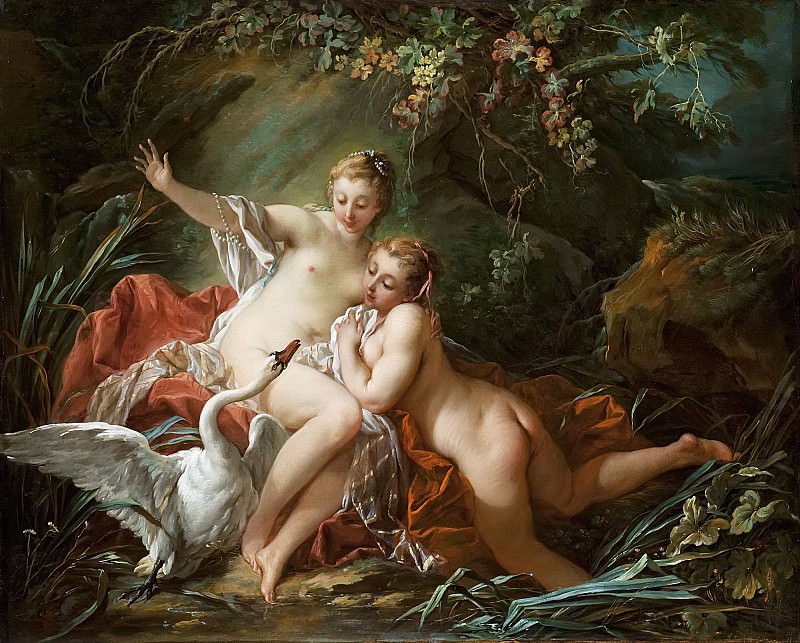Leda and the swan Francois Boucher (1703-1770)
Francois Boucher – Leda and the swan
Edit attribution
Download full size: 2000×1607 px (0,8 Mb)
Painter: Francois Boucher
Location: County Museum of Art, Los Angeles.
François Boucher was perhaps the most brilliant representative of the painting of the French Rococo era. The artist received numerous awards during his lifetime and was "his man" at the court of Louis the Fifteenth, whose portraits of his favorite, the famous Marquise de Pompadour, he painted many times. His talent is multifaceted; he painted canvases, made backdrops for theatrical scenes, created engravings, painted porcelain, painted fans and made sketches for fabrics.
A description of François Boucher’s painting "The Leda and the Swan"
François Boucher was perhaps the most brilliant representative of the painting of the French Rococo era. The artist received numerous awards during his lifetime and was "his man" at the court of Louis the Fifteenth, whose portraits of his favorite, the famous Marquise de Pompadour, he painted many times. His talent is multifaceted; he painted canvases, made backdrops for theatrical scenes, created engravings, painted porcelain, painted fans and made sketches for fabrics. But Boucher’s talent most clearly manifested itself in painting, in the depiction of mythological and biblical scenes. Pastoral landscapes and antique buildings, which did not exist in reality, always served as a background for them. Boucher sought to give mythological painting the appearance of porcelain painting. In these works he used many bright colors, but the overall tone led to a sparkling rose-gold color scheme, decorative and festive. All the characters in his genre scenes are sensual, colorful and lighthearted.
The story of Leda and the Swan is the classic story of the seduction of a young woman, the wife of the Spartan king by Zeus, who took the form of a large white bird. As a story, this legend was very popular in both art and literature. Sculptures and mosaics depicting Leda and her winged friend date back to ancient times. During the Cinquecento period the subject became particularly popular; paintings on the subject were painted by Michelangelo, Leonardo da Vinci and Caravaggio. In Boucher’s interpretation, the scene takes on a carnal and erotic tone; Leda’s body looks earthy and sexual. At the same time, the French author performs the canvas with his usual ease - unserious and glossy, it does not cause any particular base associations.
In the painting "Leda and the Swan" the white bird, curving its thin neck, tensely reaches for a beautiful naked woman. Leda looks at the swan with coquetry and lust. Such frivolous images "on the edge of propriety" were extremely fashionable at the time; wealthy people bought them to decorate interiors.
It is believed that Boucher purposely painted his works in such a way that they would blend perfectly with the color of any interior, harmonizing with tapestries, furniture, and porcelain. The rich blues and greens of the background are diluted with the soft glow of fleshy pinks and golds in the depiction of the bodies; delicate lilac reflections can be seen in the swan’s feathers. The folds of the veils are painted in deep scarlet and ochre yellow. The beauties’ bodies are painted in keeping with the fashion trends of the time - lush, plump, earthy, with an abundance of small folds. In rococo times, only this type of body was considered beautiful.
Кому понравилось
Пожалуйста, подождите
На эту операцию может потребоваться несколько секунд.
Информация появится в новом окне,
если открытие новых окон не запрещено в настройках вашего браузера.
You need to login
Для работы с коллекциями – пожалуйста, войдите в аккаунт (open in new window).














You cannot comment Why?
The subtexts of this painting are rich and varied, stemming from Greek mythology and its interpretations throughout art history. The central narrative is the seduction of Leda by Zeus, a union that resulted in the birth of Helen (of Troy), Clytemnestra, and the twins Castor and Pollux. This event is often interpreted as a metaphor for the intersection of divine and mortal realms, and the powerful, often uncontrollable forces of desire and fate.
The swans posture, gently nuzzling Leda, can be seen as symbolic of seduction, power, and the divines ability to take captivating forms. Ledas pose, with her exposed form and vulnerable yet receptive demeanor, highlights themes of beauty, temptation, and the transformative power of divine encounter. The lush, verdant setting contributes to an atmosphere of fertility and natural abundance, reinforcing the theme of procreation and the continuation of lineage.
Artistically, the painting explores themes of beauty, sensuality, and the idealized human form, common in Baroque and Rococo art. The contrast between the soft, luminous skin of Leda and the darker, more mysterious background creates a dramatic and alluring composition. The themes enduring appeal lies in its exploration of desire, divine intervention, and the consequential events that shape human history and destiny.